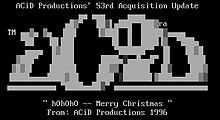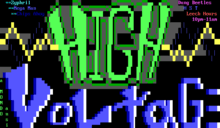ANSI art

ANSI art is a computer art form that was widely used at one time on BBSes. It is similar to ASCII art, but constructed from a larger set of 256 letters, numbers, and symbols — all codes found in IBM code page 437, often referred to as extended ASCII and used in MS-DOS and Unix[1] environments. ANSI art also contains special ANSI escape sequences that color text with the 16 foreground and 8 background colours offered by ANSI.SYS, an MS-DOS device driver loosely based upon the ANSI X3.64 standard for text terminals. Some ANSI artists take advantage of the cursor control sequences within ANSI X3.64 in order to create animations, commonly referred to as ANSImations. ANSI art and text files which incorporate ANSI codes carry the de facto .ANS file extension.
Overview

ANSI art is considerably more flexible than ASCII art, because the particular character set it uses contains symbols intended for drawing, such as a wide variety of box-drawing characters and block characters that dither the foreground and background color. It also adds accented characters and math symbols that often find creative use among ANSI artists.
The popularity of ANSI art encouraged the creation of a powerful shareware package called TheDraw coded by Ian E. Davis in 1986. Not only did it considerably simplify the process of making an ANSI art screen from scratch, but it also included a variety of "fonts", large letters constructed from box and block characters, and transition animations such as dissolve and clock. No new versions of TheDraw emerged after version 4.63 in 1993, but in later years a number of other ANSI editors appeared, some of which are still maintained today.
The decline of both BBSes and DOS users has made it difficult for many users to even view ANSI animations. As a consequence, this form of art is no longer practiced to the degree it once was.
The popular game creation system (GCS) ZZT used ANSI graphics exclusively. A later GCS based on the same concept, MegaZeux, allowed users to modify the extended ASCII character set as well.
Trade Wars 2002, a multiplayer BBS game that remains popular 20 years after its release in 1986, used ANSI graphics to depict ships, planets, and important locations, and included cutscenes and even a cinema with ANSI animations. Many of these ANSI graphics were created by Drew Markham, who went on to form Xatrix/Gray Matter Interactive and develop Redneck Rampage and Return to Castle Wolfenstein, among other titles.
See also
|
References
Bibliography
- Scott, Jason. "BBS: The Documentary" (DVD). Boston, MA: Bovine Ignition Systems, 2005.
- Danet, Brenda. "Cyberpl@y: Communicating Online". Oxford, UK: Berg, 2001. ISBN 1-85973-424-3.
- "Dark Domain: the artpacks.acid.org collection" (DVD-ROM). San Jose, CA, USA: ACiD Productions, LLC, 2004. ISBN 0-9746537-0-5.
- Zetter, Kim. How Humble BBS Begat Wired World. Wired News. June 8, 2005.
External links
- Sixteen Colors ANSI Art and ASCII Art Archive - A web viewable archive of current and past ANSI and ASCII packs released by the computer art scene
- Ansilove/PHP A set of tools for converting ANSi and ASCii files into PNG images
- A detailed table of the character set in IBM code page 437
- Perfect DOS VGA 437 (direct download): A True Type font that recreates the font characters used on ANSI artwork displayed on a VGA screen pixel-by-pixel
- ANSI Express is a freeware ANSI file viewer for Windows, which supports baud-rate emulation, ideal for playing back ANSImations.
- fTelnet Flash telnet client capable of rendering ANSI.
- FlashTerm Another Flash telnet client capable of rendering ANSI.
- http://aminet.net/package/docs/hyper/ansiguide112 - Ansi/Skypix Specs and Tutorials at Amiga Aminet official repository (in AmigaGuide and text format).